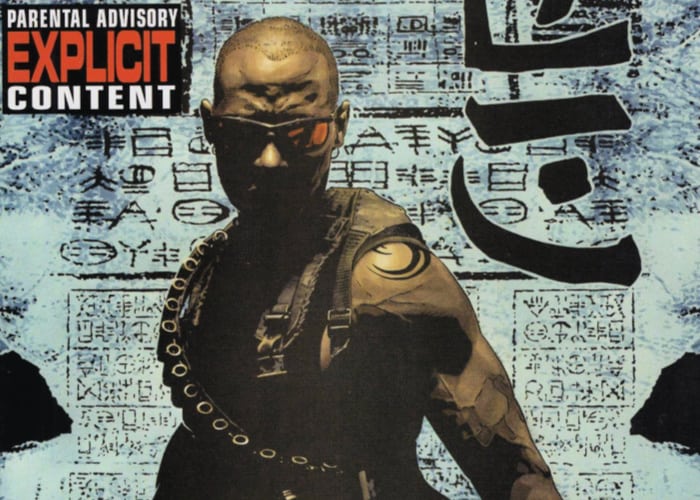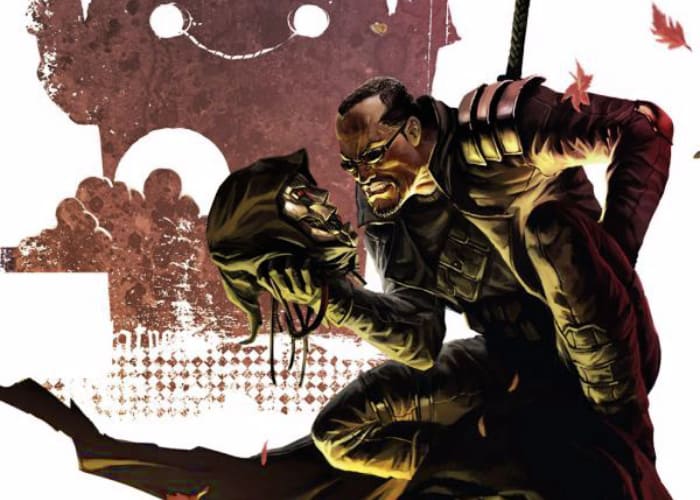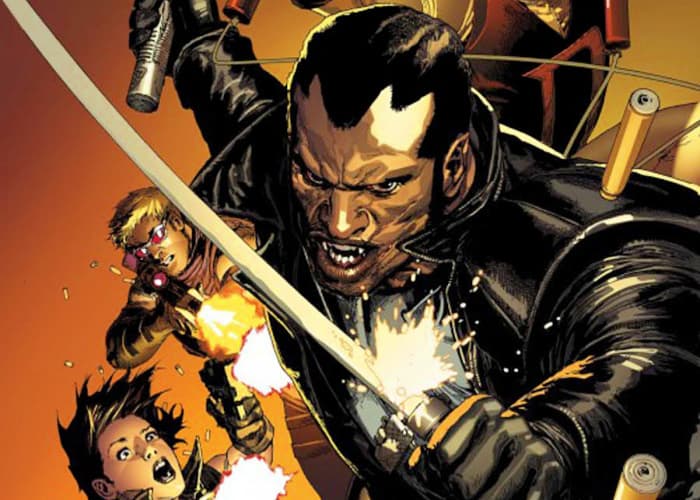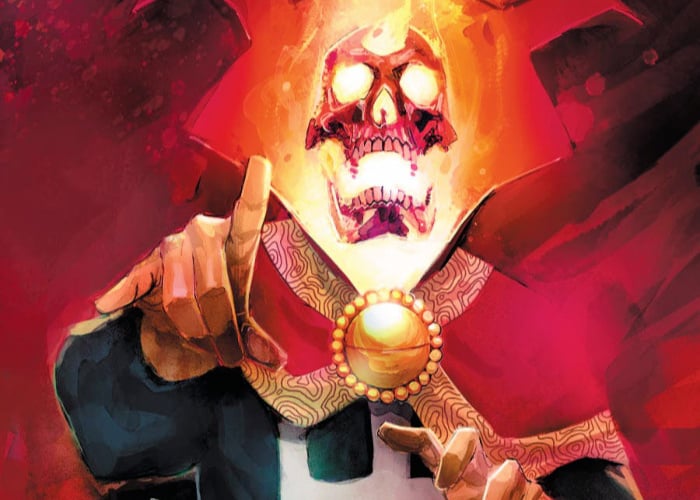Better put those ice skates away, Blade is back. Probably the last Marvel superhero we expected to be announced at this year’s San Diego Comic-Con, the Daywalker brought the house down in a big way thanks to the Academy Award-winning actor attached to the role. To hear Marvel Studios head Kevin Feige tell it, without the interest of Mahershala Ali, the chances of Blade‘s resurrection were pretty slim. Hell, the original vampire slayer, Wesley Snipes, was still holding out hope that he’d get another crack at the bat — or stake as the case may be.
A lot of credit gets thrown to the first adaptation from 1998. As our own Kieran Fisher states in his guide to superhero horror movies, “Until Blade came around, comic book movies were stuck in a rut.” From its success stems 20th Century Fox’s foray into the X-Men universe and Sony’s swing at Spider-Man. The rest, as they say, is history.
The effect of removing Blade from the timeline is debatable. What’s not debatable is the massive alteration a character like Frank Brooks (a.k.a. Frank Blade) will have once inserted into the Marvel Cinematic Universe. As Thor eased audiences into the more fantastical elements of Marvel comics in 2011 and Doctor Strange introduced magical terrors in 2016, Blade will smash down the supernatural door barely left hanging by the hinges after Scott Derickson hopefully swings it wide in his 2021 sequel Doctor Strange in the Multiverse of Madness. Vampires, werewolves, demons, oh my.
Blade first appeared as an antagonist to Bram Stoker’s infamous bloodsucker in Tomb of Dracula #10. Written by Marv Wolfman and penciled by Gene Colan, the character was a stereotypical blaxploitation avenger that quickly overtook the rest of the book. Wolfman was so concerned by the larger-than-life personality that he pressed pause on his narrative, removing Blade from the title for almost a year. When Blade returned, his dialogue was a little less problematic (uhhhhh — still not great) but a lot duller. Many writers would have their hand at Blade, dropping him into comics like Adventures into Fear, Ghost Rider, and Morbius. He failed to exhilarate.
The truth is that you have to give most of Blade’s respectability to Snipes. After 1998, Marvel Comics had a financially successful model to follow, and the Daywalker began to resonate on a deeper level alongside the usual superhero suspects. We need to ask the man himself, but I’m guessing that whatever fandom Ali has formed around the character has its roots in Snipes’ portrayal. As such, if you’re looking to study up on Blade, the best comics to launch your odyssey were published in the last 20 years. For those still interested in the character’s origins, I would recommend experimenting with the compilation Blade: Black and White. Inside you’ll discover a smattering of Blade’s early appearances and few curious excitements like Blade: Crescent City Blues #1 and Marvel Shadows and Light #1.
5. Blade MAX Vol. 2 (2004)

This mature content (blood, sex, swears) collection of comics is a little tricky to track down but well worth doing so if you have the money and the time. Writer Christopher Hinz and artist Steve Pugh basically do their take on Guillermo del Toro’s Blade 2 with the Daywalker taking on other vampire-killing vampires that are more mutant than simple creatures of the night. The real appeal is Hinz’s ability to transfer Snipes’ cool stillness to the page and deliver a threat fitting of the superhero confines. After all, vampire slayers practically grow on trees these days, so the Marvel variety needs to up its game from the usual literary or Universal Monster threats. Comic book vampires gotta offer more than fangs and bat wings.
4. Blade: Undead Again (2007)

Ok, this one is a little nuts, but hear me out. The Daywalker is a Marvel Comics Superhero. That means he needs to interact with other Marvel Comics Superheroes, battling the big threats back-to-back with The Avengers. Published a few years after the Max line of comics reached their end, Blade: Undead Again pits Blade against Doctor Doom, Spider-Man, Dracula, Wolverine, and a shopping mall Santa Clause. I probably lost you on that last one, but I’m asking you to trust me. Artists Howard Chaykin and Marc Guggenheim run Blade through a gauntlet of characters and it is as compelling as it is silly. On top of all that, this quick miniseries found new ways to expand on the Daywalker’s beginnings, introducing Blade’s complicated and self-involved father.
3. Captain Britain and MI13: Vampire State (2009)

In all seriousness, the nifty thing about Blade coming to the MCU is to witness him clash against our most beloved characters. Stuck in his corner of the franchise, Blade is not that interesting. Battling vampire hordes next to spandex-clad European badasses like Captain Britain and The Black Knight is our jam. When the British government runs afoul of Dracula, there is only one ally to call. Blade + Excalibur = hell, yeah.
2. Ultimate Comics Avengers: Blade vs. The Avengers (2011)

From the violently demented brain that brought you Wanted, Kick-Ass, and Kingsmen. Mark Millar‘s Ultimate Comics Avengers: Blade Vs. The Avengers technically takes place in an alternate reality from the other three storylines, but it’s always healthy to shake things up with a multiverse. Looking at Phase Four of the MCU, movie audiences are going to have to adjust to this concept quickly. When vampires begin transforming superhumans into their kind, S.H.I.E.L.D. reluctantly teams-up with the Daywalker. The situation escalates quickly, and the heroes nearly succumb to the bloodsuckers until Captain America gets…worthy. Yup. Avengers: Endgame has nothing on this patriotic sledgehammering climax.
1. Doctor Strange: Damnation (2018)

This is a comic book epic that spans multiple supernatural Marvel titles including Doctor Strange, Ghost Rider, Iron Fist, and Ben Reilly: Scarlet Spider. All hell breaks loose after Stephen Strange attempts to magically aid the crumbling city of Las Vegas (see the controversial Secret Empire). The demon Mephisto summons an army of Ghost Riders to wage war against the Sorcerer Supreme, and his BFF Wong is forced to call reinforcements. Answering the alarm is an eclectic band of B- and C-list characters including Blade. While our favorite hero is somewhat second fiddle in this book, the moments he gets shine viciously. We’ve seen the Daywalker take on numerous vampires in the past, but for the character to properly settle into the MCU he needs to prove his worth against the cosmic threats. Blade is more than a vampire slayer. He can kick a demon’s ass just as well. He does plenty in Damnation.
The post The ‘Blade’ Reading List appeared first on Film School Rejects.



0 comments:
Post a Comment